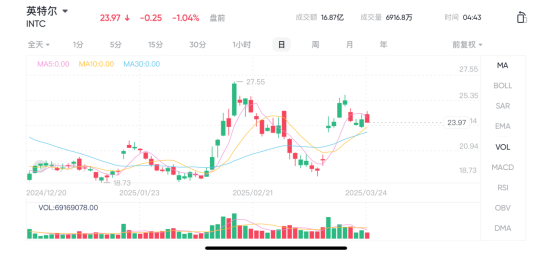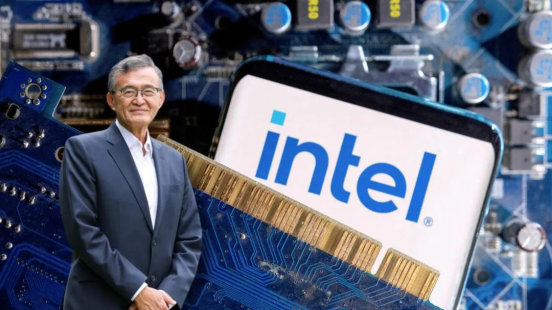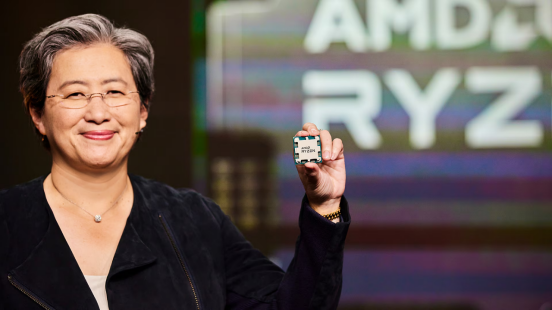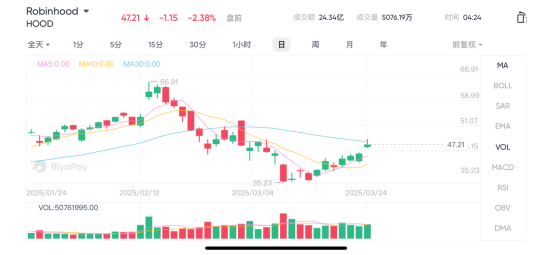- EasyCard
- Trade
- Help
- Announcement
- Academy
- SWIFT Code
- Iban Number
- Referral
- Customer Service
- Blog
- Creator
Preparing to buy these two US technology stocks reminds me of her back then!
Intel, the chip giant that once dominated the world, is now deeply mired in a huge loss of 19 billion dollars, its market value is constantly shrinking, and its competitors are pressing forward step by step! At this critical moment, a Chinese boss - Chen Liwu, was appointed as the CEO of Intel! As soon as he took office, he made tough promises - to comprehensively reform the manufacturing and AI businesses, lay off the bloated management team, and push the company back to its peak!
But here comes the question, can Intel really turn the tide with this transformation during its darkest moment? Can he lead Intel to win this “chip counterattack battle”? This reminds me of Su Zifeng, who led AMD back from the brink of bankruptcy.

Will history repeat itself with Intel? In addition, I am also preparing to buy a rapidly rising fintech company. Its stock price has fallen 45% from its historical high, and its huge development potential makes it attractive. I will delve into why I am optimistic about this company from multiple perspectives such as its financial performance, valuation, and growth potential.
Let’s take a look at the new CEO of INTC first.
Chen Liwu (born in 1959 in MY) is a legendary figure in the semiconductor and venture capital fields. He was admitted to Nanyang Technological University in Singapore at the age of 16 and later received a Master’s degree in Nuclear Engineering from MIT and an MBA from the University of San Francisco. In 2022, he won the “Nobel Prize” in the semiconductor industry - the Robert Noyce Prize. These backgrounds laid a solid foundation for his later achievements.
Chen Liwu has nearly 20 years of experience in the semiconductor industry. During his tenure as head of EDA giant Cadence from 2009 to 2021, he led the company to double its revenue, soar operating profits, skyrocket its stock price by 3200%, and exceed a market value of $65 billion. In 1987, at the age of 28, he founded Walden International, focusing on semiconductor, internet, and new energy investments, managing over $3 billion in capital and investing in more than 500 companies, including over 120 semiconductor companies.
He adheres to the investment philosophy of “long-termism”, and the most classic case is SMIC: as a founding shareholder, he has persisted for 18 years without exiting. In 2020, he promoted it to become the first “A + H” red-chip Listed Company, setting a record for the largest IPO of Class A Share in ten years. The leading investment companies he led, such as Zhaoyi Innovation and Allwinner Technology, have built the map of China’s semiconductor industry.
Joined Intel’s board of directors in 2022, but resigned two years later (August 2024) due to management differences with CEO Kissinger. By the time Kissinger stepped down in December of the same year, Intel’s market value had evaporated by $150 billion, with a historical loss of $18.80 billion and a serious setback to its foundry strategy.

However, when Chen Liwu took over as CEO of Intel, it reminded me of the situation when Su Zifeng took over AMD.
In 2014, when Su Zifeng was appointed CEO of AMD, the company was on the verge of bankruptcy with a debt of $2.20 billion, and its market share was squeezed by giants such as Intel and Nvidia. She decisively laid off 7% of its employees, raised $600 million through technology licensing, and led the team to launch the revolutionary Zen architecture (performance improvement of 52%) in 2017, completely reversing AMD’s fate and returning it to the high-performance computing track.
The current situation of Intel is mirroring that of AMD in the past: although it maintains its market position, its foundry strategy has been frustrated, its technology iteration has lagged behind, and its market value has evaporated by $150 billion in three years, facing strong competition from competitors such as TSMC. Chen Liwu, who once created the market value myth of Cadence and promoted the rise of semiconductor companies such as SMIC, left the Intel board of directors in 2024 due to management differences. His profound industry resources and investment courage are still highly expected. Whether he can replicate Su Zifeng’s comeback script may become the biggest suspense in the semiconductor industry in the next decade.

Can Chen Liwu’s “Three Fires” turn the tide?
The first fire: bringing Intel Foundry, Intel’s foundry manufacturing business, to the forefront.
Although this business has always been low-key in the past, for Chen Liwu, it is the key to rebirth. Currently, Intel manufactures chips for large companies such as Microsoft and Amazon. Although its performance is not as eye-catching as TSMC, Chen Liwu is very clear that it is necessary to attract more customers in order to return to the peak. By promoting this business, Intel can attract more large customers and bring stable sources of income to the company. In the short term, it may have a positive impact on Intel’s stock price, especially in the context of optimistic prospects in the chip industry, which may boost market confidence in Intel.
The second fire: reforming Intel’s internal architecture. Chen Liwu has been criticizing Kissinger’s decisions internally. Directly pointing to the bloated architecture left by Kissinger, he plans to streamline redundant teams, break the bureaucratic culture, and regain Intel’s “paranoid survival rule”. Previously, he resigned due to dissatisfaction with internal inefficiency, and now intends to improve decision-making efficiency through architecture slimming, paving the way for financial recovery.
The third fire: bet Intel’s future on AI. Bet on the next generation AI chip Panther Lake, relying on 18A advanced process technology to break through. Whether it can establish deep cooperation with NVIDIA and Google will determine Intel’s life and death in the AI chip market.
In addition to these three fires, another topic that the market is concerned about is the compensation plan. Chen Liwu’s salary includes a 1 million dollar annual salary + 2 million bonus, and more importantly, the 66 million dollar equity stake incentive (strongly linked to the stock price). His out-of-pocket 25 million dollar stock purchase and lock-up operation deeply binds personal wealth to the fate of the company. If the strategy is effective, it may replicate the legend of leading Cadence’s market value to 32 times that year.
HOOD: A 45% pullback in fintech startups, a value depression or a risk trap?
Recently, market fluctuations have caused many investors to have doubts about fintech companies, especially companies like Robinhood (HOOD). People are worried that the instability of the stock market will lead to a decrease in retail trading, thereby affecting their profitability. However, the fact has proved that HOOD has not been affected by short-term market fluctuations.

In the first quarter of 2025, the stock price of Robinhood (HOOD) fell by 45%, and its market value evaporated by more than $30 billion. However, the latest financial report data revealed business resilience that contradicts the stock price trend, making it the most controversial fintech target in the current market.
Business resilience comes from three core advantages
In February 2025, Robinhood’s stock trading volume reached $142.90 billion, a year-on-year increase of 77%, far exceeding market expectations. Its growth is not dependent on a single business: options trading revenue accounts for over 60%, four times that of stock trading; cryptocurrency trading volume increased by 122% year-on-year, maintaining revenue resilience through derivative services. In addition, one-third of the revenue comes from user cash spreads. In February, the net inflow of deposits was $4.80 billion (a year-on-year increase of 28%). The “Gold Member” system continues to increase user stickiness through deposit rewards and credit card cashback.
Despite a planned 10% increase in operating expenses, the company expects revenue to grow 25% to $3.69 billion in 2025, with an adjusted EBITDA margin of 60%, up 32 percentage points year-over-year. Balance Sheet is robust: net cash reserves of $5.25 billion, no long-term debt, and a cash flow coverage ratio of 180%.
The current market value is 35.50 billion USD, and the enterprise value after deducting net cash is only 29.50 billion USD. In terms of expected revenue, the PS multiple of 11 times is lower than the industry average of 15 times; the EV/EBITDA multiple of 16.6 times is significantly lower than the S & P 500 index’s 20 times. Compared to the peak of 80 times Price-To-Earnings Ratio in 2023, the current valuation fully reflects the market’s pessimistic expectations.
The uncertainty of cryptocurrency regulation remains the biggest concern, and the recent review by the US SEC has led to some business adjustments. In addition, there is a risk of cyclical fluctuations in the active level of retail trading, and the growth rate of new users has slowed to 5%. However, the company’s advantages in options trading (market share of 28%) and cryptocurrency wallets (12 million users) have not yet been fully realized, and the Network Effect of technology platforms may provide support for future growth.
Investment strategy: Emphasize both investment platform and timing
For Value Investors, Robinhood’s current valuation reflects the worst-case scenario. However, if regulation becomes stricter or user growth stagnates, there is still room for valuation to decline. The contradiction between its high growth and low valuation is essentially a game between market regulation and innovation in the fintech industry. Investors need to dynamically evaluate its risk-return ratio during the window of industry change. Investors can match the multi-asset trading wallet BiyaPay to track the real-time stock price dynamics of Intel and HOOD, and deposit and withdraw US dollars/Hong Kong dollars to their bank accounts through their supported digital currencies (such as USDT), and flexibly deposit and withdraw funds to brokerage platforms. As a professional deposit and withdrawal tool, BiyaPay not only simplifies the process of US stock trading, but also helps investors quickly adjust Asset Allocation, Risk Diversification and capture growth dividends in volatile markets.
Finally
Intel’s high-risk, high-return attributes are suitable for aggressive investors who need to closely track the progress of its foundry and AI chips; HOOD provides high-growth opportunities in the financial technology track, with more attractive valuations after a pullback. The combination of the two, combined with the advantages of the multi-asset trading wallet BiyaPay, can build an investment portfolio that is both offensive and defensive.
*This article is provided for general information purposes and does not constitute legal, tax or other professional advice from BiyaPay or its subsidiaries and its affiliates, and it is not intended as a substitute for obtaining advice from a financial advisor or any other professional.
We make no representations, warranties or warranties, express or implied, as to the accuracy, completeness or timeliness of the contents of this publication.




Contact Us
Company and Team
BiyaPay Products
Customer Services
is a broker-dealer registered with the U.S. Securities and Exchange Commission (SEC) (No.: 802-127417), member of the Financial Industry Regulatory Authority (FINRA) (CRD: 325027), member of the Securities Investor Protection Corporation (SIPC), and regulated by FINRA and SEC.
registered with the US Financial Crimes Enforcement Network (FinCEN), as a Money Services Business (MSB), registration number: 31000218637349, and regulated by FinCEN.
registered as Financial Service Provider (FSP number: FSP1007221) in New Zealand, and is a member of the Financial Dispute Resolution Scheme, a New Zealand independent dispute resolution service provider.




















